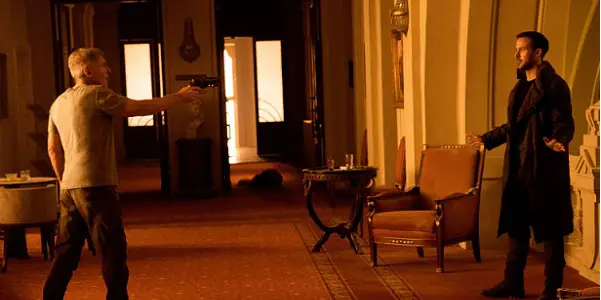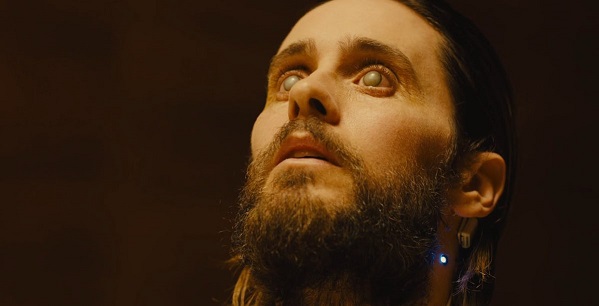BLADE RUNNER & The Violence Of Civilization

Hazem Fahmy is a poet and critic from Cairo. He…
The source of all conflict in the world of Blade Runner is the humanity of the replicants. As an enslaved population, they seek the means to pursue their own destiny, to break free from the chain that is their programming. It is, of course, perfectly logical for a sentient group to reject their harsh state, but the very existence of their sentience seems illogical in the first place.

Replicants were engineered by humans for the specific purpose of being a sustainable source of slave labor; a workforce whose exploitation could not be questioned. But they can only be described as exploited because of their personhood, which humanity consciously gave them. In other words, you can’t enslave a non-sentient machine. A fridge or a tractor have no desires of their own.
Whether or not (and how) you use them bears no impact on their feelings or sense of self. Even a veteran blade runner like Deckard cannot deny the objective fact that replicants feel pleasure and pain, have distinct personalities, and pursue personal goals.
The Burden of Being Human
By enshrining them with humanity, humans have made replicants into slaves, rather than machines that simply function like any other. Replicants would not have asked for, nor even needed, rights if they couldn’t produce value and a sense of self independence of the labor they were designed to do. There’s an absurd cruelty to Tyrell’s active choice to make replicants as human as humanly possible, knowing they were entering a world that had no intention of acknowledging that humanity.
This ostensible paradox makes the Blade Runner films unique among popular A.I. fiction and cinema. In your average tech-gone-rogue tale, machines are given sentience due either to clear motivation or to a mistake on the part of the creators. In Alex Garland’s eerie Ex Machina for example, Nathan is a hubris-drunk, borderline mad scientist who is obsessed with achieving a kind of godhood, hence he strives to be the one man who triggers the singularity, and the result is Eva. There’s a clear reason for Nathan’s pursuit of A.I., but he fails because he underestimates the power of his creation. Anyone who’s barely paying attention to American cinema knows how common this trope is, from 2001 and The Matrix, to The Terminator and Age of Ultron.

Humans also underestimate replicants, to catastrophic results, but, again, it seems unclear why Tyrell and later Wallace, chose to make them so human. Though the answer doesn’t manifest smoothly in the plot or the world’s logic, a look at the thematic arcs of both films reveals a fascinating meditation on the relationship between violence, exploitation, and civilization.
In one of the most fascinating sequences of Blade Runner: 2049, Jared Leto’s spacey Wallace, in reference to replicants, bluntly states: “All great civilizations were built on slavery.” This is literally true. From antiquity to European colonialism, all the way to America itself, slavery, whether in the sense of chattel slavery or the forced labor of the occupied, is perhaps the single most common feature of ‘great’ civilizations.
This is perhaps what makes Wallace such an interesting and terrifying villain. He is by no means unaware of what he is doing. He does not deny the humanity of replicants. To him, they are simply a source of labor that is easier to control.
Humanity & Slavery
Though Wallace’s villainy can seem almost cartoonish at times, it is brilliant when framed in the context of that quote. Rather than clichéd sociopathy, his coldness stems from an extreme form of commitment to humanity that is as pluralistic as it is viciously narcissistic. In this sense, Wallace is a terrific embodiment of the colonial ‘enlightened’ Western man. This is abundantly clear in the horrific scene in which he slaughters the freshly born female replicant. He doesn’t kill her in rage or frustration, it’s another mechanical process, and that nonchalant attitude speaks volumes to the exploitation of women in Wallace’s ‘great’ project of civilization, one that reduces their value to their wombs.

Whereas the first Blade Runner struggled with the definition of humanity, 2049 goes after its value. Wallace does not need to demean a creature’s humanity in order to justify their enslavement; he knows what he is doing, he knows it is causing pain and suffering, but he does not care because all lives are disposable before the altar of civilization.
In this way, 2049 pushes us to question the very value of civilization, or at least what we have come to define as such so far. The scientific advancements of the Wallace Corporation have supposedly led to an era of unprecedented prosperity, one even greater than that of the first Blade Runner. Yet what does that matter to our characters? Who among the impoverished masses has time to care about what is literally out of this world?
One of the most powerful decisions in both films is that we never actually get to see the off-world colonies. We are told time and time again that people are trying to get there and that life there is thriving, but we have no idea what that looks like, or if it is even true for that matter. All we see is the ruins of Earth, a freezing Los Angeles and a radioactive Las Vegas. By aligning us with those who were left behind, those who are marginalized in this universe, both films implicitly negate the value of civilization. What good is the glory of replicant technology if it leads to both human and replicant suffering? What good is space travel if California is in ruins?
Conclusion
Perhaps this is where Wallace’s blindness comes in (using blindness as a motif is, of course, very iffy, but as it is still normalized in literature and film, one cannot ignore it). It is at once a subversion of the blind wise man trope, as Wallace has an incredible vision, but it is far from a benevolent one, but it also demonstrates the powerful’s obliviousness to the weak. He cannot see that civilization does not matter to the impoverished masses that Deckard and K meet who are simply trying to get by and survive. He only sees the stars.
Do you think Neander Wallace is a compelling villain?
Does content like this matter to you?
Become a Member and support film journalism. Unlock access to all of Film Inquiry`s great articles. Join a community of like-minded readers who are passionate about cinema - get access to our private members Network, give back to independent filmmakers, and more.
Hazem Fahmy is a poet and critic from Cairo. He is an Honors graduate of Wesleyan University’s College of Letters where he studied literature, philosophy, history and film. His work has appeared, or is forthcoming in Apogee, HEArt, Mizna, and The Offing. In his spare time, Hazem writes about the Middle East and tries to come up with creative ways to mock Classicism. He makes videos occasionally.













